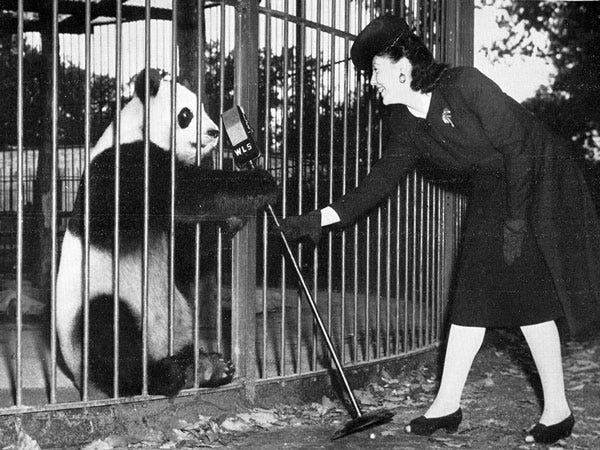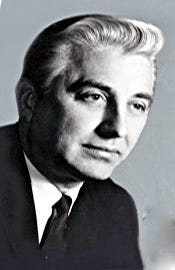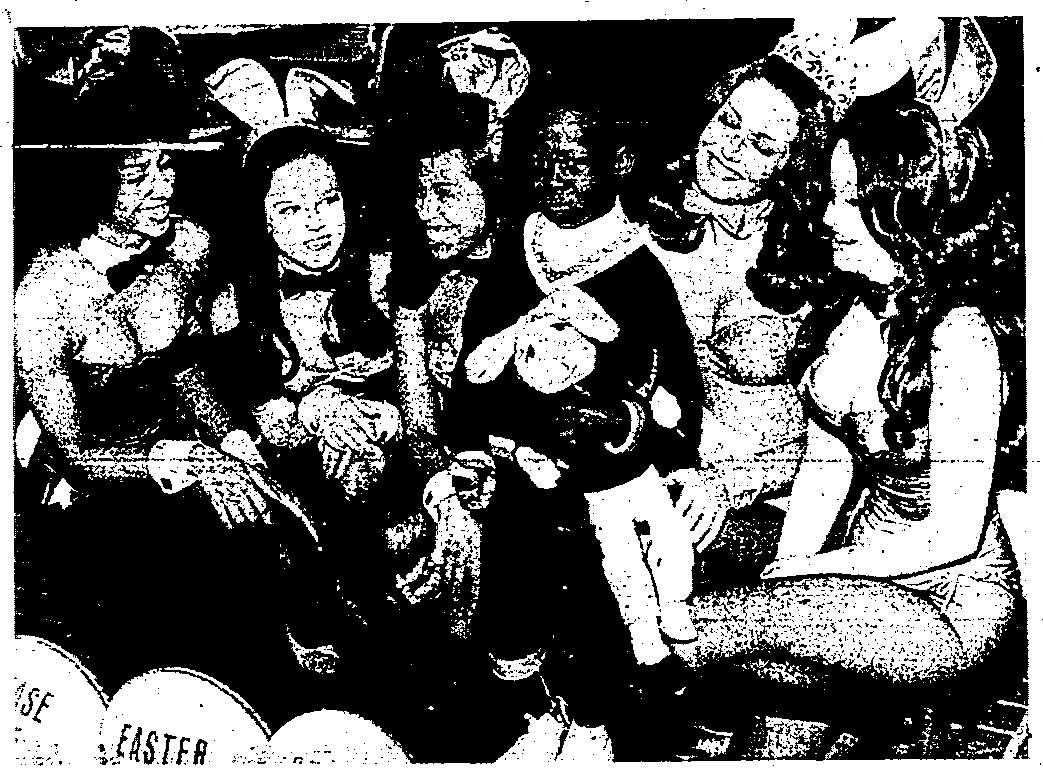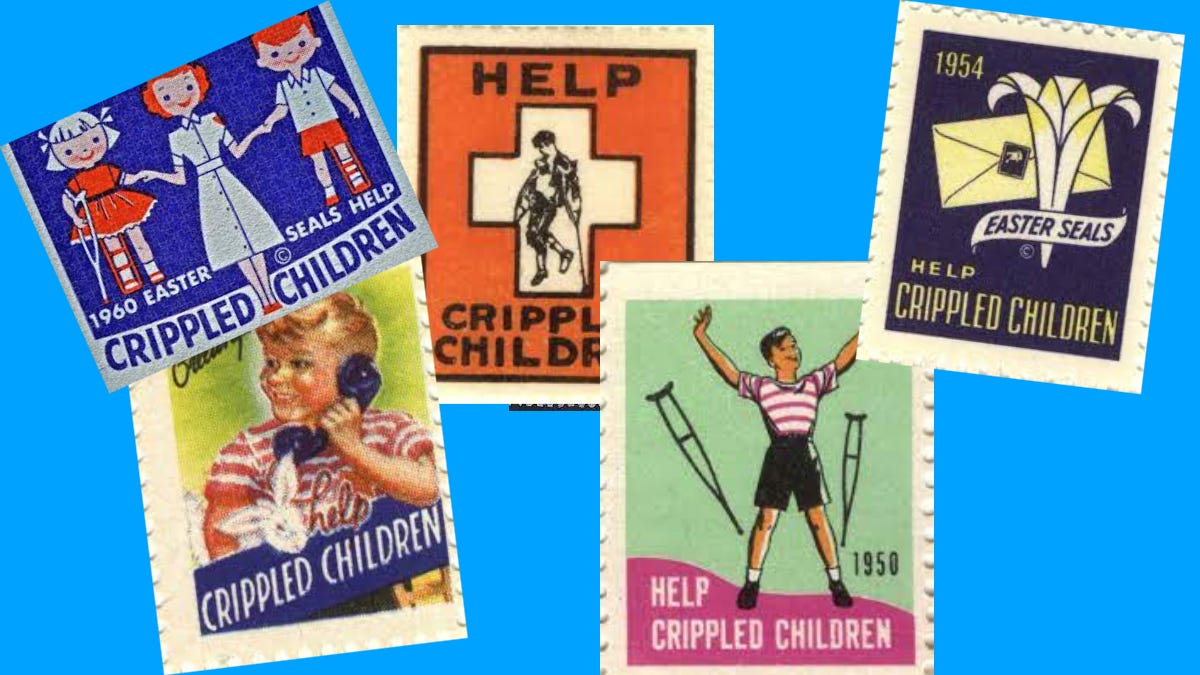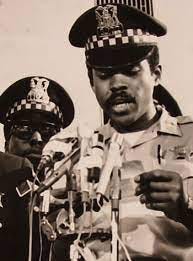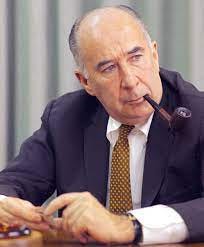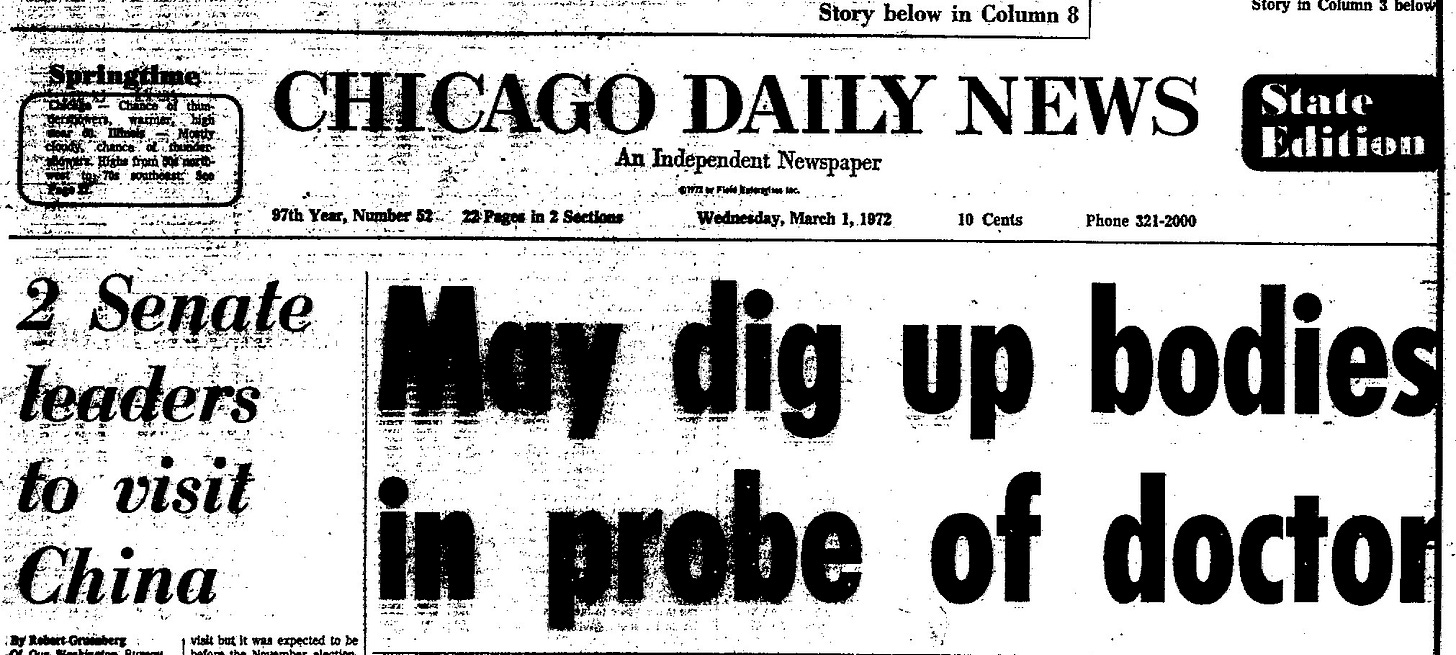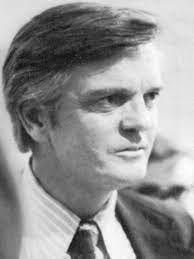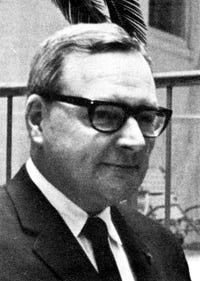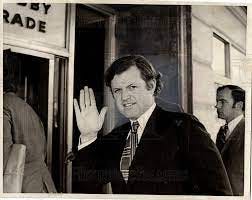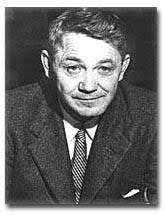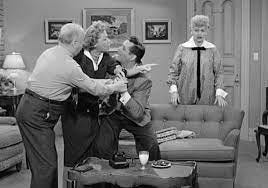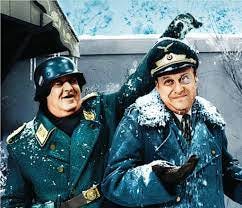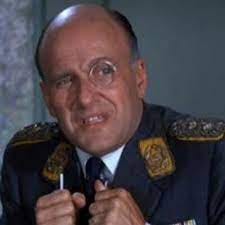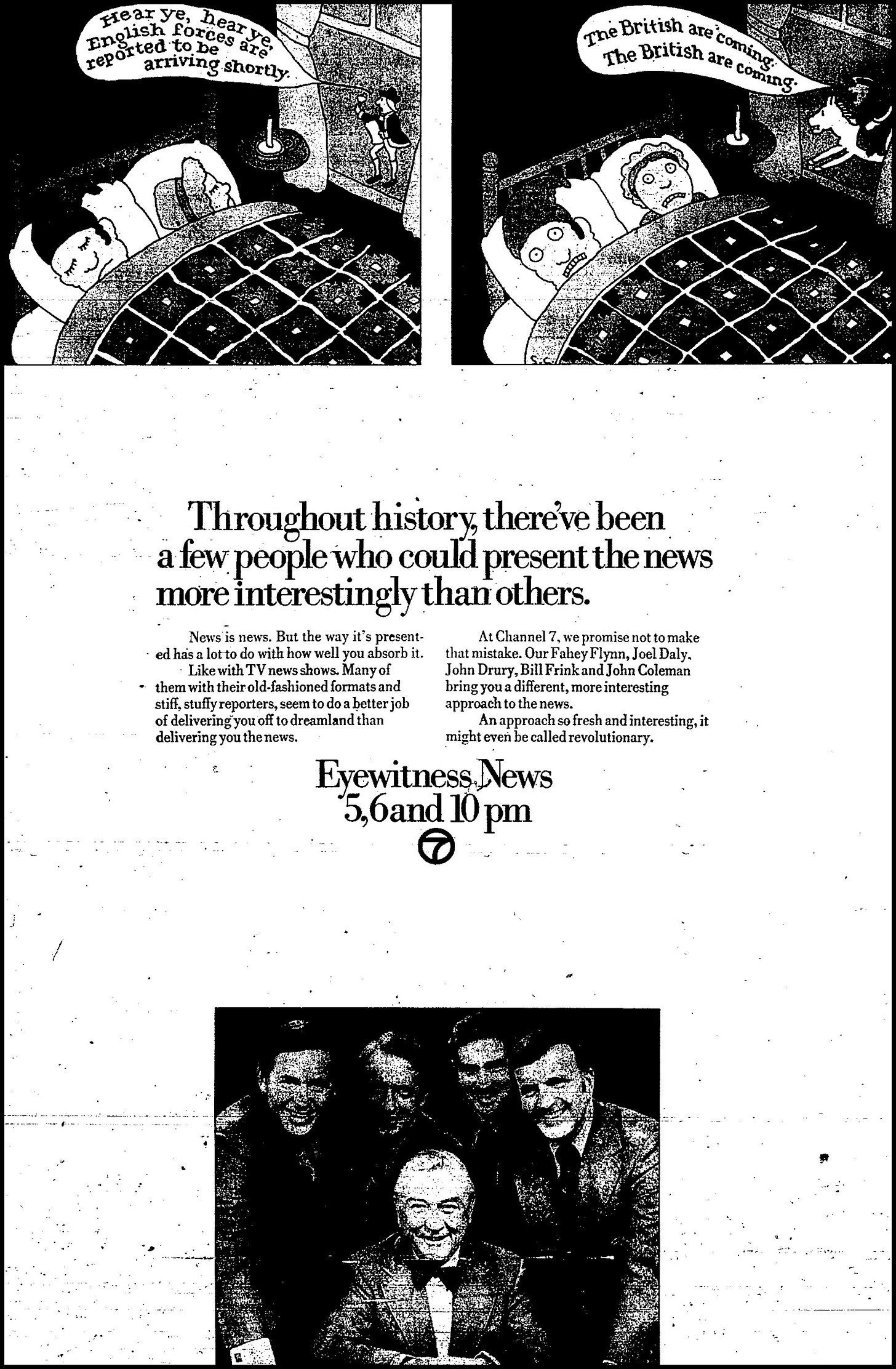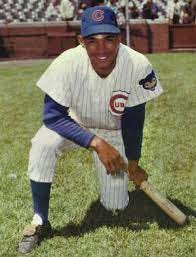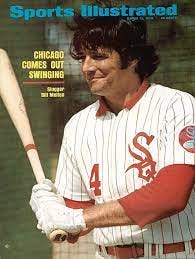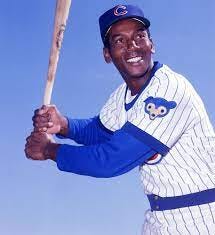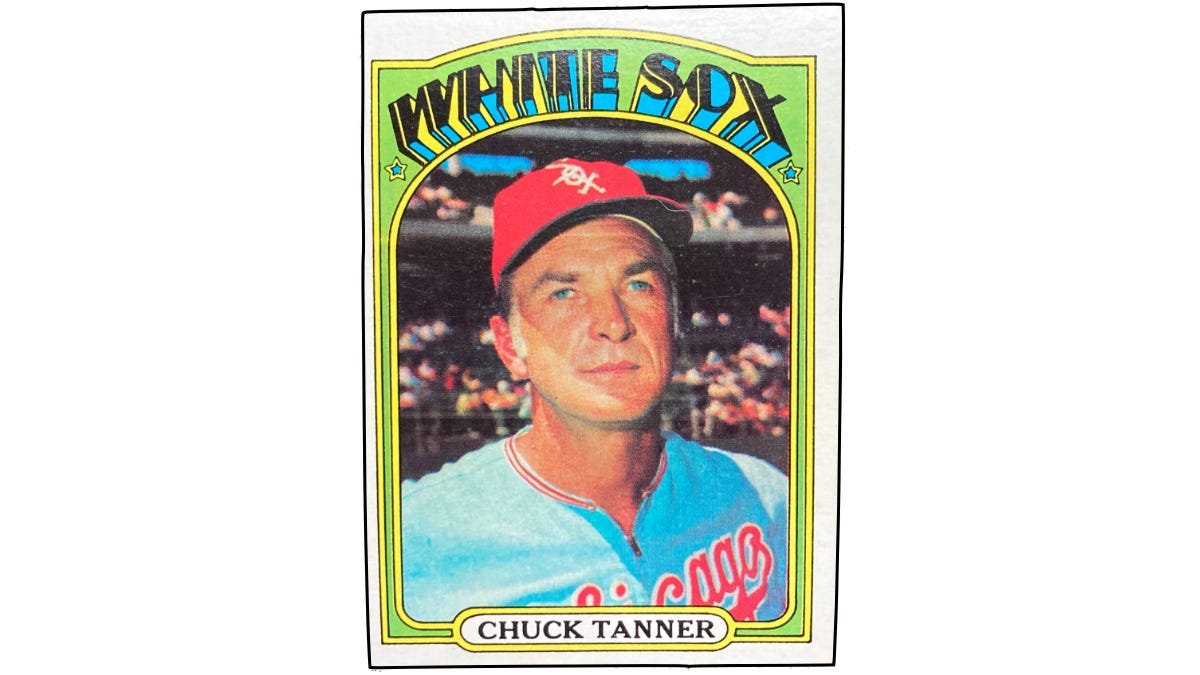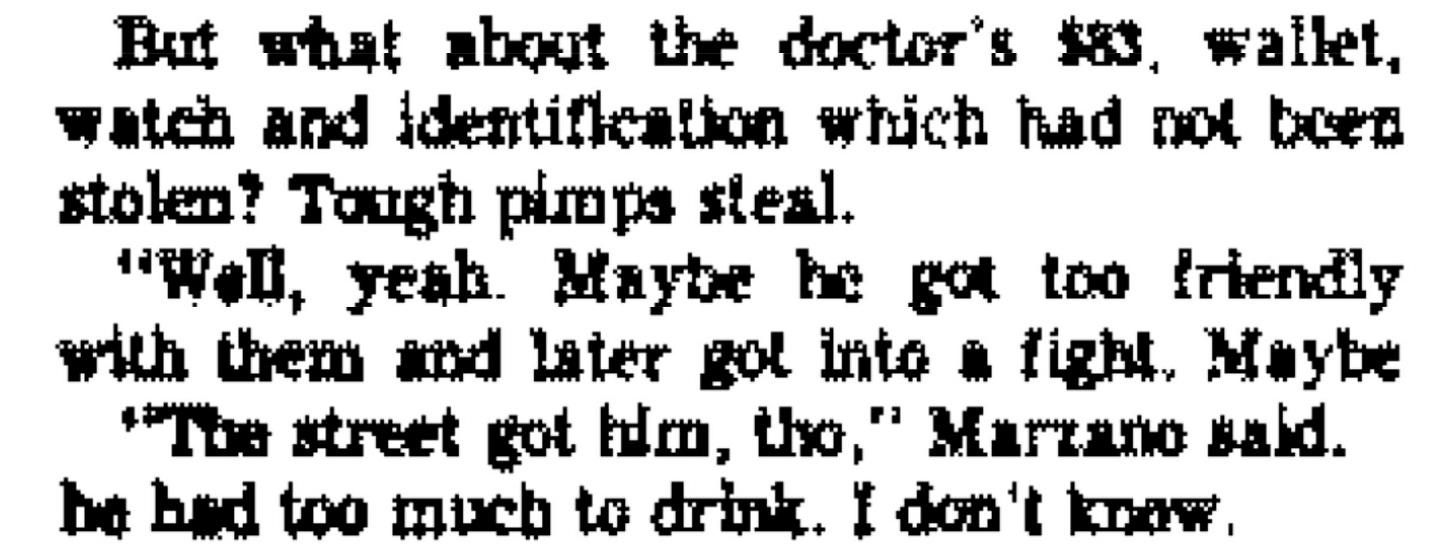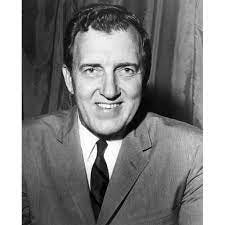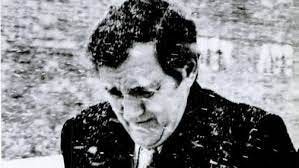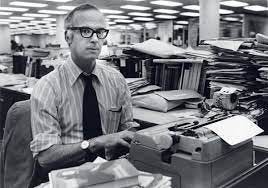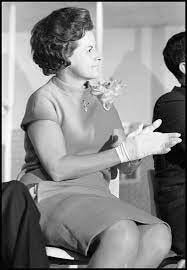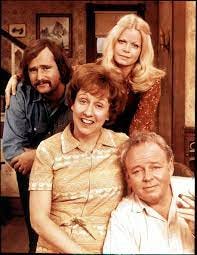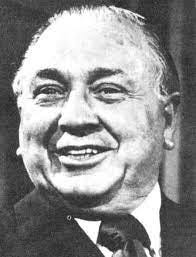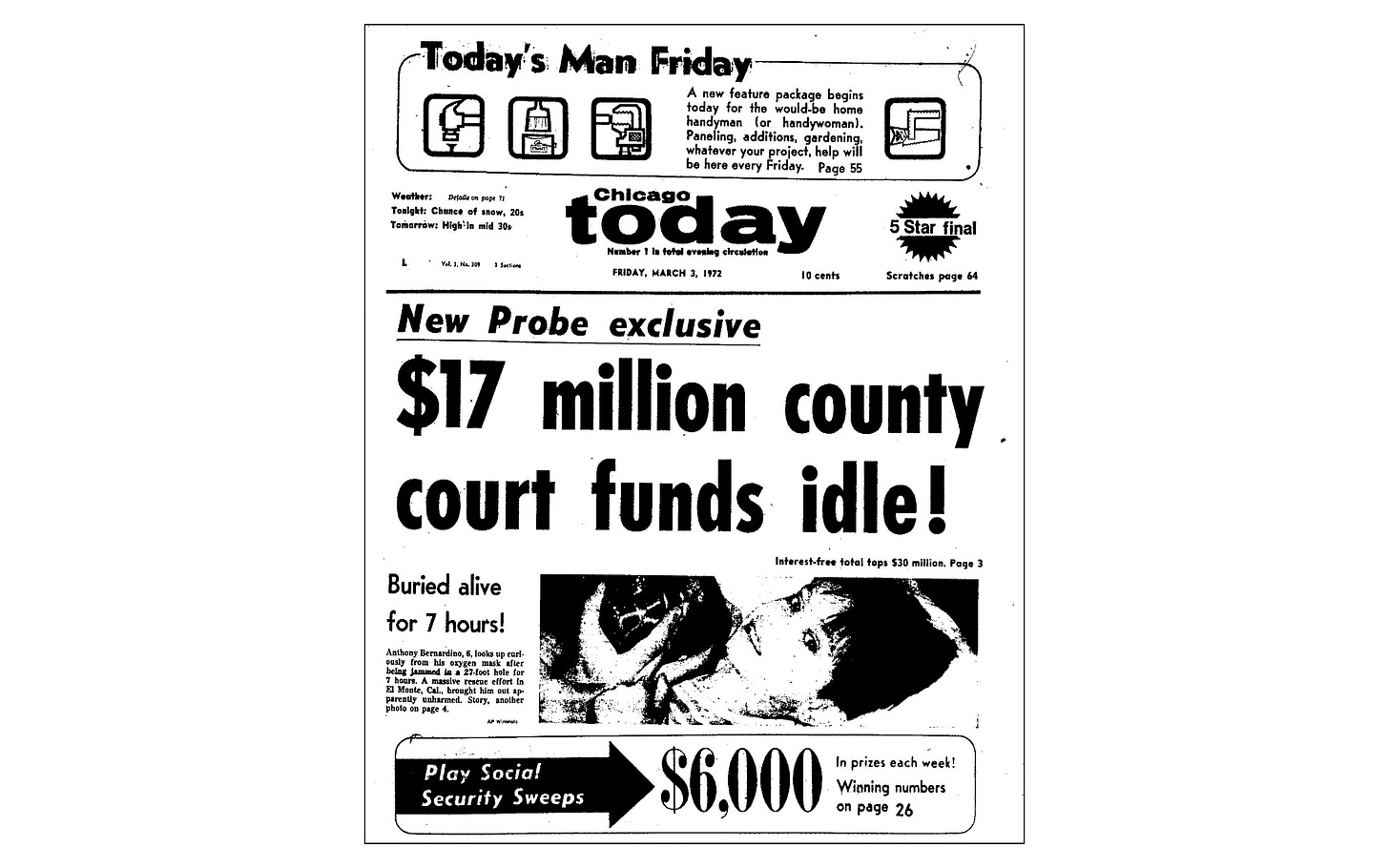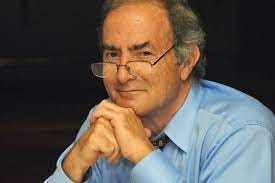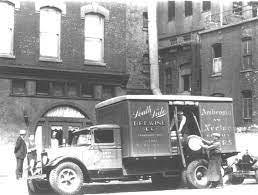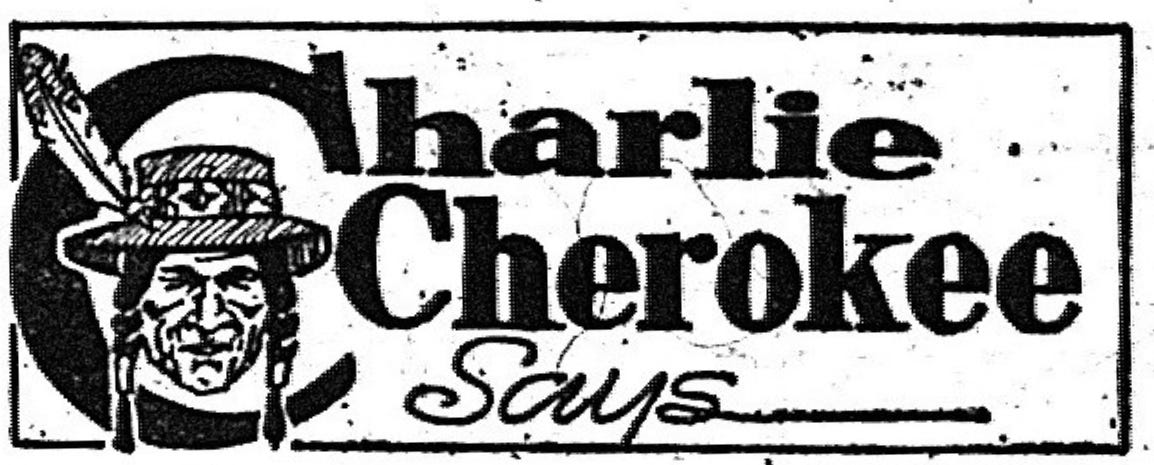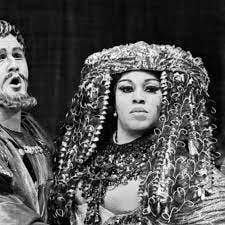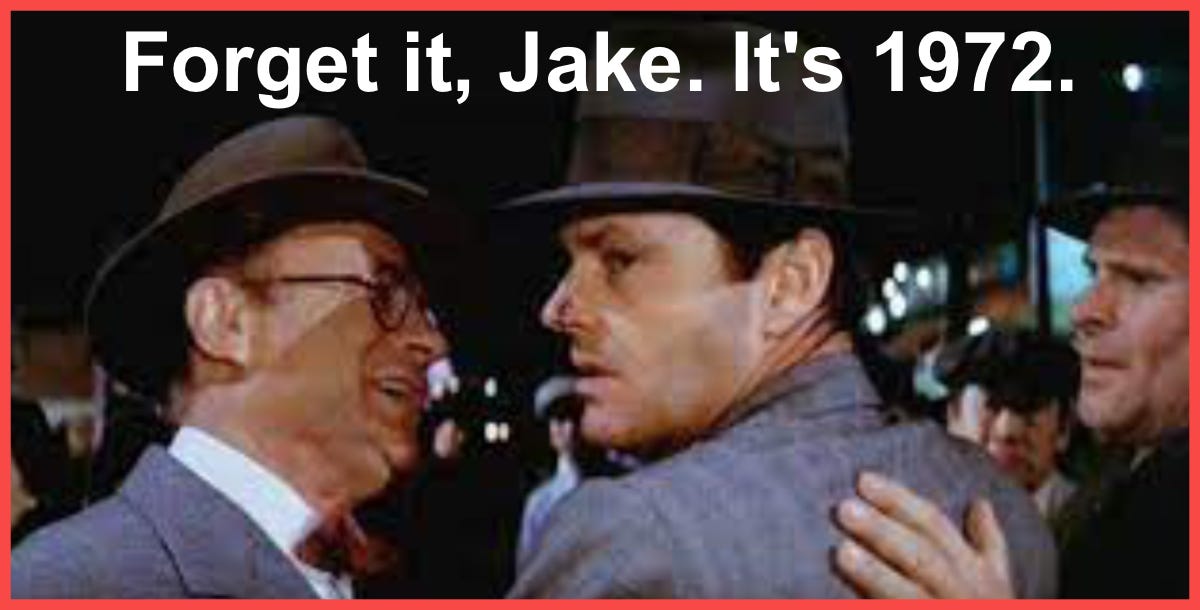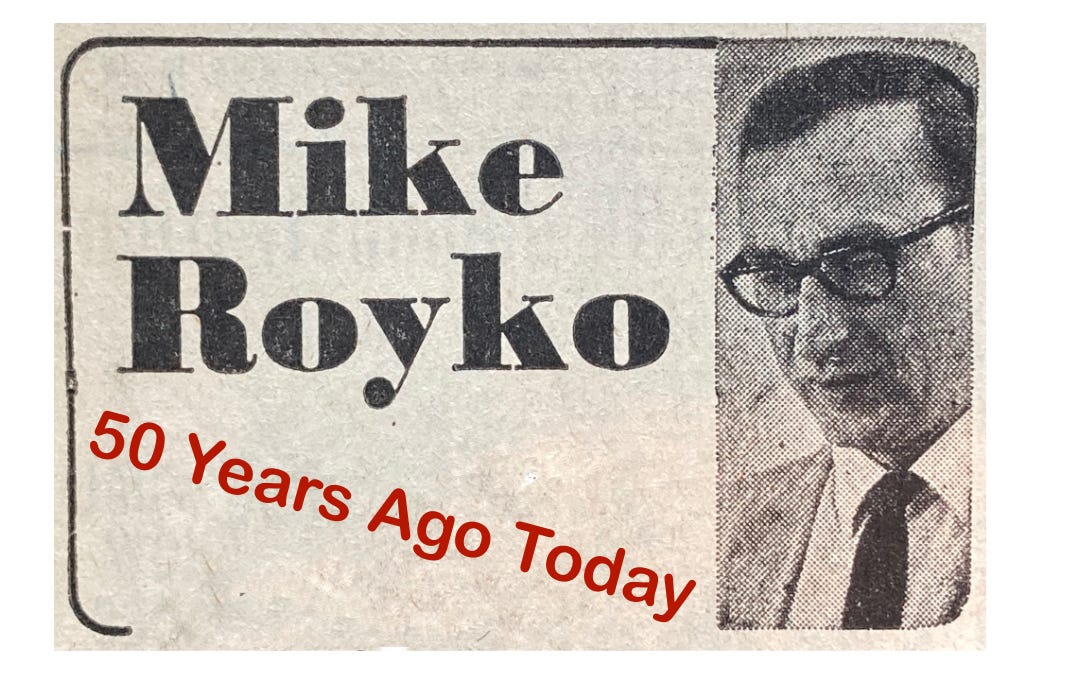THIS CRAZY DAY IN 1972: Playboy bunnies frolic with a handicapped child for charity
February 28, 1972 - March 5, 1972
To access all contents, click HERE.
Why do we run this separate item peeking into newspapers from 1972? Because 1972 was part of the ancient times when everybody read a paper. Everybody, everybody, everybody. Even kids. So Steve Bertolucci, the 10-year-old hero of the novel serialized at this Substack, read the paper too—sometimes just to have something to do. These are some of the stories he read. If you’d like, keep up with the 1972 papers every day on Twitter, @RoselandChi1972.
February 28, 1972
Chicago Daily News: Panda ‘fever’ rises
By Tony Fuller
Premier Chou En-lai has promised President Nixon two giant pandas during his historic China trip. Everybody wants those pandas.
“A growing epidemic of panda-mania swept into the Chicago area Monday,” writes Fuller, without mentioning that the Daily News is promoting the mania relentlessly with an editorial, and now daily panda stories with its own logo:
The Daily News wants to own this story because the paper's former publisher, Colonel Knox, gave Brookfield Zoo its first (and the country's first) giant panda in 1938.
Here is the new panda being "interviewed" by WLS.
“Hundreds of school children wrote the White House, saying they want the rare animals in Brookfield Zoo….A Chicago restauranteur said he would import all the bamboo shoots the pandas can eat,” the Daily News reports.
Dan Walker, Democratic candidate for governor, and U.S. Rep. Roman Pucinski, who’s running a hopeless campaign for U.S. Senate against incumbent Republican Sen. Charles Percy, have both glommed onto the panda hoopla. Pucinski is shameless pandering (no pun intended) to every possible voter group right now.
“‘Panda power should return to Brookfield zoo. For years, pandas and Brookfield were synonymous,’ said Pucinski.”
See the December 6 entry for Mike Royko 50 YEARS AGO TODAY to get some telling background on Pucinski.
February 28, 1972
Chicago Daily News: Bunnies join Danny’s drive
A charity for handicapped children is promoting its fundraising by posing a handicapped child with scantily-clad cocktail waitresses in costumes meant to titillate men.
“Five pretty Playboy bunnies took time off from their nightclub chores Monday to help a 7-year-old crippled boy launch the 1972 Easter Seal campaign,” writes the Daily News. “The boy, Danny Pleasant, of 1423 E. 72nd St., clutched a big white fluffy rabbit as the toothsome waitresses from the Playboy club played with large Styrofoam eggs.”
The Easter Seal drive used to be a very high profile annual fundraising campaign in Chicago. The Chicago- and Washington-based group was founded in 1919 and started its Easter Seals campaign in 1934. The group started out as “the National Society for Crippled Children,” then became “Easter Seals” in 1967, and now it’s “Easterseals.” The Easterseals website says it is the largest nonprofit health care organization in the country, serving over 1.5 million per year, now including adults too.
Somehow, the group just isn’t as well known as it once was, when it ran its yearly fundraising campaign during Lent. Then, the group sold big stickers called “Easter Seals” that people added to envelopes along with stamps, to show their support.
The Easterseals website says they mail the seals now, "to more than 19 million households across the country every year, raising over $13 million to support services to people and families with disabilities."
February 29, 1972
Chicago Daily Defender: Stay granted in Kenwood probe
By Lucille Younger
NAACP lawyers got a stay on a grand jury subpoena to testify about their investigation into the February 15 fatal shooting of Cornelius Fitzpatrick at Kenwood High School by a Chicago cop moonlighting as a security guard.
“Chief Criminal Court Judge Joseph A. Power stayed the NAACP’s motion until March 9,” so NAACP officials won’t have to appear before the grand jury before then.
NAACP executive director Andrew Barrett and field director Sydney Finely “were ordered to appear before the grand jury on Feb. 23, after they publicly stated that an extensive investigation should be launched into the shooting of Fitzpatrick, who was killed by Wentworth ave. robbery investigator Bernard Martin in the west hallway of Kenwood High School, 5015 S. Blackstone ave.”
“Five days later, the NAACP attorneys appeared on their behalf asserting in a legal brief that ‘the subpoena interferes with the constitutional rights of black people to organize collectively to try to protect themselves,” and that it ‘constitutes an unreasonable search and seizure of information, documents and records representing the NAACP.’
“Both attorneys charged that the subpoena was ‘vague, nebulous, broad and general,’ and that it was geared exclusively as a fishing expedition for an indepth examination without legal grounds into the affairs and activities of the NAACP.”
“Meanwhile, the president of the Afro-American Patrolman’s league, Renault Robinson was ‘grilled’ for two hours by a grand jury about the deaths of both Fitzpatrick and Louis Redmond, 21, who was shot by police on Feb. 7 on the city’s Westside.”
TIME IS ALMOST UP TO WIN COOL 1972 SWAG! Chapter 4: The Gately’s Doughnut drops in two weeks, signaling the end of the contest. Check out the full prize list HERE.
March 1, 1972
Chicago Daily News: Link Mitchell, ITT deal, $400,000 gift to GOP
By Jack Anderson
Daily News Columnist
If I didn’t know Watergate was coming, I’d say this scandal has it all.
“We now have evidence that the settlement of the Nixon administration’s biggest antitrust case was privately arranged between Atty. Gen. John Mitchell and the top lobbyist for the company involved,” thunders Jack Anderson’s front page column.
Jack Anderson is, of course, the uber-famous nationally syndicated columnist who broke about a thousand exposes. He’ll win a Pulitzer in 1972 for reporting on secret dealings between the U.S. and Pakistan during the 1971 India-Pakistani war. Anderson doesn’t work for the Daily News, as the byline claims. The Daily News carries his syndicated column.
“We have this on the word of the lobbyist herself, crusty, capable Dita Beard of the International Telephone & Telegraph Corp. She acknowledged the secret deal after we obtained a highly incriminating memo, written by her from ITT’s files,” writes Anderson.
“The memo, which was intended to be destroyed after it was read, not only indicates that the antitrust case had been fixed but that the fix was a payoff for ITT’s pledge of up to $400,000 for the upcoming Republican convention in San Diego.
“Confronted with the memo, Mrs. Beard acknowledged its authenticity. The next night, badly shaken and acting against the wishes of ITT officials who wanted her to leave town, she met with my associate Brit Hume at her home to try to explain the document.
“By this time, she said, ITT security officers from company headquarters in New York had put most of her office files through a document shredder to prevent their being subpoenaed after disclosure of the memo.
“Mitchell denied that he had made a ‘deal’ with Mrs. Beard and said President Nixon never pressured him to reach a settlement with ITT.”
ITT denies everything too, as does the now federal judge who handled the case as a Justice Department antitrust specialist.
But I smell a lot of headlines to come.
March 1, 1972
Daily News: May dig up bodies in probe of doctor
By Phillip J. O’Connor and Dennis Sodomka
There’s about 200 bodies involved here.
Dr. Ricardo Munoz-Velez was suspended from Elgin State Hospital because it turns out he’s not a doctor, “may not have finished medical school” and “may have used fake documents to get his job”.
If the Kane County State’s Attorney William Ketcham presses charges, they’ll probably have to dig up 200 patients who died under Munoz-Velez’s care. Dr. George Leroy, professor of internal medicine at University of Chicago, investigated and wrote a report on Munoz-Velez’s performance.
“Ketcham said the specific accusations are that Dr. Munoz’ treatment of patients was totally incompetent, grossly negligent, showed a complete disregard for the welfare of his patients” and--what else do you need?
March 1, 1972
Chicago Daily News: Legislators get on panda bandwagon
The typesetters could save time just laying out “pandapandapanda” ever since Premiere Chou En-lai promised two pandas to President Nixon on his ongoing historic trip to China.
A rare bipartisan piece of legislation to get Chinese pandas in Brookfield Zoo passed in Springfield, sponsored by Illinois House majority leader Henry Hyde (R-Chicago) and minority leader Gerald Shea (D-Riverdale).
“’We’re all ape over pandas. Bring ‘em back to Brookfield,’ said Hyde… ‘I look a bit like a panda myself,’ said the rotund Hyde.”
Chicago Park District President Dan Shannon issued a statement demanding the pandas for Lincoln Park Zoo instead. “Shannon, angered by the intensive drive to locate the pandas at Brookfield, vowed to personally go to China and get some pandas if Lincoln Park does not get the presidential pair.”
Do you remember Dan Shannon from Mike Royko’s January 13 column?
March 1, 1972
Chicago Daily News: Swingingest campaign gala of season staged by League of Women Voters
Everything turns into panda news these days in 1972.
The League of Women Voters held a shindig that attracted every possible political candidate at The Red Garter, 21 E. Pearson, and it was a swinging time. Democratic candidate Dan Walker, running for governor against incumbent Republican Richard Ogilvie, acted like the comer he is.
Walker “pumped the hand of the man he’d like to oust from the Executive Mansion,” wrote Daily News political editor Charles Nicodemus, meaning Gov. Ogilvie. Then Walker “walked up on stage” and “urged his own election and said he finally hoped to ‘bring a high level of competence to Springfield.’”
“Republican Ogilvie scratched his nose at that remark. When Walker was done, Mrs. Ogilvie graciously smiled and applauded. The governor did neither. Then Ogilvie strode to the platform and said flat out:
“I want you to know I’m on the right side of one of the day’s hotter issues. I want both those pandas for Illinois.”
March 1, 1972
Chicago Today: Slain GI’s dad rips amnesty
WASHINGTON--The distraught father of an American soldier killed in Viet Nam shouted at a Senate hearing yesterday that the same politicians who ‘passed laws that sent men to their deaths’ in Southeast Asia now are proposing amnesty for ‘draft dodgers who crawled to Canada.’”
“As Chairman Edward M. Kennedy (D. Mass.) listened in silence, 48-year-old Martin Kelly of Boston told the senator’s judiciary subcommittee that, rather than talk about amnesty, Congress should talk about building a monument to the more than 50,000 servicemen who died in Viet Nam. Kelly’s son, Daniel, 20, was killed in the A Shau Valley in 1968.”
“The Boston man’s testimony, at times delivered in angry shouts, came shortly after historian Henry Steele Commager said a total amnesty was vital to heal the ‘psychological and moral wounds’ of the Viet Nam war.
“Commager, a professor of history at Amherst college, told the packed hearing that, as in previous wars, the country should welcome back its men who would not fight.
“May not the deserters and evaders claim that their error is to have been ahead of public opinion and of government policy and that it should be easy to forgive this error?” Commager asked.
“Afterward, David Harris, folksinger Joan Baez’s husband who served nearly two years in prison for resisting the draft, said he and others like him want an apology from the nation, not forgiveness.”
…. “Kelly, a Massachusetts state employe, blistered several politicians, among them the late President Kennedy. He said that the late President’s inaugural pledge that the United States would ‘bear any burden’ in the fight for liberty prompted many men to enlist and helped hasten the Viet Nam war buildup.”
“Now, Kelly said, the late President’s brother, Edward, ‘has turned around’ on the war and is seeking to ‘imply righteousness to draft dodgers who have crawled to Canada or Sweden or wherever they could pull their holes in over them.”
“Kennedy, listening intently to Kelly, whom he had invited to testify, made no statement after Kelly finished.
“The testimony came in the second day of hearings into proposals for Viet Nam amnesty. Sen. Robert Taft Jr. (R., Ohio) among others has introduced legislation that would provide amnesty to draft evaders who agreed to work for a specified period of national social service. Taft’s measure, however, excludes deserters.”
BTW, I’m all too capable of typos, but “employe” is not one of them. That’s the Tribune, which is still using the late Colonel McCormick’s simplified spelling, even though the Colonel died in 1955. Chicago Today is owned by the Trib. Rather than continually explain this, you’ll sometimes see this logo.
March 1, 1972
Chicago Today: Jack Mabley - Print public payrolls each month?
“’If you really want to put the egg in the fan, back legislation requiring the publication in daily newspapers every month of public payrolls.’
“This delightful suggestion comes from Charles Liebman, a lawyer whose avocation is putting burrs under saddles.
“Another legislative proposal. After my item Monday about getting a ticket for not having my vehicle sticker displayed, a note from the boss asks:
“’How about joining my campaign to have license decals issued in the summer? They won’t stick on cold surfaces--so they issue them in January.’
“The answer: After I got the ticket, I stuck the decal on the windshield. It curled off. Too cold.”
FYR: The required annual Chicago city vehicle sticker used to be nearly impossible to remove from the inside of your windshield. You could spend half your Saturday morning with a razor blade trying to scrape one off. This is why you routinely saw cars with 3, 4, or even 5 years of expired stickers in a column marching down the passenger side of many windshields--you’d rather obscure your line of vision and run someone over at a stop sign than try getting the old ones off.
But today’s issue is that in 1972 apparently, they also made the stickers so that they would NOT stick to the windshield when it was cold out. I didn’t know that.
Also, Jack Mabley was the star columnist of the Daily News before jumping to Chicago’s American—making room for a new columnist at the Daily News who turned out to be Mike Royko. Mabley then became the star at Chicago’s American, which was renamed Chicago Today, moving on to the Tribune when Today folded in 1974. Yet everybody forgot about Mabley so quickly. Quite a few newspaper people working at that time told me that Chicago’s American and Chicago Today had no star columnist—but they did. It was Jack Mabley. Did everyone forget Jack Mabley because Mike Royko sucked up all the journalistic air in town? Not sure. I’ll be doing a post on Mabley soon.
March 2, 1972
Chicago Today: TV Report - Crane still a hero to viewers
By Bruce Vilanch
Recognize the name? I mean Bruce Vilanch, not “Crane.” Bruce Vilanch doesn’t mince words in his opinion of several hit TV shows here, but the column goes somewhere unexpected.
“Quiz. What TV performer would you guess is seen in more cities at more different times of the day for more moments each week than any other? Well, it’s no contest. Obviously Lucille Ball is the champ.”
Anyone alive in 1972 who spent a day in bed with the flu watching reruns knows how true this statement is. Lucy had three shows--I Love Lucy, The Lucy Show, and Here’s Lucy, so it was impossible not to end up watching some Lucy.
“But who would you say is second?” asks Bruce Vilanch. “Take a minute.”
The winner is Bob Crane. This is going to be the review of “Hogan’s Heroes” you didn’t know you needed to read, 51 years after the show ended.
You cannot go anywhere in the United States “without seeing him sometime, somewhere, somehow….Crane’s series--Hogan’s Heroes--was probably the worst comedy show ever put on TV. A direct steal of the hit Broadway and Hollywood property, ‘Stalag 17,’ Hogan’s was all about the jolly goings-on in a World War II prisoner of war camp (Stalag 13, they called it). Crane played Hogan, the William Holden part, and there were the lovable Nazis, lovable French resistance fighters and lovable American slobs of the Bilko stripe around, too.”
“Everything about Hogan’s Heroes stank. The idea was obscene, the caricatures were gross, the acting predictable and forced. But the show was a tremendous hit, just like Gilligan’s Island, the second worst comedy show ever put on TV. And just like Gilligan’s, it has earned an entirely new life in reruns.”
Bruce Vilanch’s assessment of “Hogan’s Heroes” is absolutely spot-on, yet the very insanity of placing a sitcom in a Nazi prisoner-of-war camp is exactly what made the show endlessly fascinating to watch. I mean, lovable Nazis? And this was before “The Producers,” too. “Hogan” began in 1965. “The Producers” came out in 1967. Perhaps it was just in the air—the need to start making fun of Nazis. After all, Hogan began exactly 20 years after the end of World War II.
The odd thing is that Bruce described Hogan’s Heroes to his 1972 audience the way I would describe Hogan’s Heroes here in 2022 For Younger Readers. Believe me, there wasn’t a single person except in Amish country who didn’t know all about Hogan’s Heroes.
Back to Bruce’s review: So, thanks to reruns, “Bob Crane is a television star today. Still. And like all good television stars, he is absolutely aware of how meaningless his vehicle was and how, basically, TV is just a way of feeding a family while you do what you really want.”
Vilanch spends the second half of the column telling how Bob Crane wants to produce a comedy on Broadway. He’s just doing endless cameos on Love American Style, or hosting the Chicago Auto Show as he is apparently doing this week in 1972, to pay the bills.
Also, Bob Crane likes to drum. He had them put a drum room into a building on the Desilu production lot, and in between scenes of Hogan’s Heroes, he would go put on a record and drum along. Remember that next time you think of Colonel Klink yelling, “Ho-GAN!!!!” And try to forget everything you know about what came out about Bob Crane after his murder.
Do you not know Bruce Vilanch? Bruce Vilanch will leave Chicago Today and go to Hollywood. Wikipedia incorrectly says he worked for the Tribune. This makes sense from Wikipedia though: “As an entertainment writer, he began spending time with as many celebrities as would let him.” Wikipedia says Bruce Vilanch made friends with Bette Midler this way and wrote material for her 1974 Broadway show. And he was off!
You may know Vilanch for his time on Hollywood Squares, or for famously writing for the Oscars show for many years, among so many other enterprises including his 2000 off-Broadway show “Bruce Vilanch: Almost Famous.”
And he got his start at Chicago Today.
March 2, 1972
Chicago Today, front page: Suburban college closed in uprising
“An estimated 150 blacks barricaded themselves inside the Fine Arts building at Triton Community College in west suburban River Grove today, forcing the disbanding of classes and the closing of the campus.
“The demonstrators, which included ‘some non-students,’ according to River Grove police, demanded a Black Student Center and other benefits.
“School officials ordered the college closed after thousands of students began milling around the college and a false fire alarm was sounded….There were no reports of fighting or other violence.
“The blacks had staged a sit-down Tuesday, but returned to clases today after the administration threatened them with expulsion.”
A later edition of the paper includes a story by Jeff Lyon with more detail:
“Continued haggling with black students over a permanent black student center has led administrators of west suburban Triton College to call off classes indefinitely.
“The decision to suspend classes at the state’s largest junior college was made early today by Triton’s Board of Trustees, it was learned.
“About 50 blacks yesterday took control of the almost all-white Fine Arts Building and held five Triton administrators hostage for more five hours.
“The captive men were released from the steel-and-glass building on the River Grove campus about 6:30 last night after an afternoon of negotiations. The black students had prepared a list of negotiable demands and grievances.”
….“It was learned from a number of sources that [a Black student center] is the key issue leading to yesterday’s incident, in which slight damage was caused to the building and one faculty member suffered minor injuries.”
March 2, 1972: The Mighty IC
Chicago Tribune
Regular readers will recall that the Illinois Central commuter train serving the South Side and south suburbs has racked up a dismal record lately: Eighteen serious delays in the last four months of 1971, and at least five screw-ups so far in 1972, making tens of thousands of passengers up to an hour late for work.
Nine unnamed IC executives talked to Tribune reporter Thomas Buck last month and blamed the service outages and delays on their fleet of nearly 50-year-old train cars. But the executives also admitted they decided four years ago to stop fully maintaining those old cars, because they’re waiting on delivery of new double-decker cars. The IC executives asked customers to be patient, because all the new double-deckers will be in service by this summer.
Well, now it’ll be December 1.
Frank E. Rizzuto, director of commuter operations and services, told an Illinois Commerce Commission that the fleet of 130 new double-deckers will all be working by December 1.
Rizzuto also said 44 new double-deckers are operating already, and the IC is receiving deliveries of two new cars each week from the manufacturer.
“The I.C. asked the commission to rescind its order that the railroad rehabilitate and modernize 40 old commuter cars at a cost of $2.2 million to be used during rush hours.”
ICC hearing examiner Joseph McHugh “Indicated the order might be rescinded” in June, if the IC is able to get more federal and state money to buy an additional 15 new double-decker cars.
March 2, 1972
Chicago Today: 50,000 draft limit this year
AP
“Secretary of Defense Melvin R. Laird said today he hopes to cut the nation’s draft to 50,000 men this year. ‘Our goal is still an all-volunteer force by June 30, 1973,’ he said.
“Laird said the draft was 300,000 in 1969, the year he took office, 200,000 in 1970, 100,000 last year, ‘and we hope to cut it in half again this year.’”
March 2, 1972
Chicago Tribune: Clarence Peterson column
‘Happy Talk’ on 10 O’Clock News: An Old Idea with a Catchy Name
“Is ‘happy talk’ rotting the minds of Americans? Are we learning to laugh at tragedy and disaster? Is news content being sacrificed for the sake of fun and reassurance?”
Tribune TV critic Clarence Petersen notes that Newsweek just weighed in on the “happy talk” trend on news shows. Peterson claims Chicago’s ABC affiliate, WLS-TV, started “happy talk” on its news shows— “despite attempts by New York’s WABC-TV to claim credit”.
“It began by happy accident, and grew thru a promotional campaign that exploited it. The term itself was coined by Morry Roth, Chicago correspondent for the show business weekly, Variety.”
Petersen defines the term for us: “It is the easy, informal style of the news, sports, and weather reporting and the banter that passes between the news, weather, and sports reporters.”
And even though Ch. 7 and its anchors are known for ‘happy talk’—Fahey Flynn and Joel Daley are the main anchors—Petersen says all the stations do it now to some extent “even as they deplore the style and especially the name as a WLS-TV gimmick.”
“The new WBBM-TV news team—Bob McBride, Brent Musberger, John Coughlin, and John Madigan—is as addicted to happy talk as are WLS-TV’s Flynn-Daley-Coleman-Frink. The essential difference is the new [Channel 2] team is not yet settled in, and the banter is so labored that you often wonder if McBride will ever quite get Musberger or Coughlin introduced and, if so, if he’ll ever get the camera back.”

Petersen quotes a Chicago Journalism Review analysis that found 10:23 minutes of actual news on the Ch. 5 10 PM newscast; 11:31 minutes on Ch. 7; 11:26 on Ch. 2; and 12:30 on Ch. 9. So none of them give you all that much news in a half hour.
Petersen says he figures “there is as much frivolity among viewers who watch channel 5 because Floyd Kalber is handsome as among those who like to see John Coleman jump out on a fire escape during his weather report. The important thing is that since happy talk arrived at channel 7, channel 7’s newscasts have arrived at the top of the ratings.”
“So it must work—but what is it that worked? ….Happy talk, in fact, is not really so new. Frivolity in 10 o’clock newscasts is as old as TV news. Only now it has a catchy name, one that gets it discussed and dissected.”
March 3, 1972
Chicago Today: Rick Talley sports column
Sox welcome another fan into the fold
“Sarasota, FL—Conversation with an 8-year-old Cub fan:
“Okay son, I’m going to take you to the White Sox practice this morning.”
“Are they any good?”
“Sure they’re good, and they’re getting better.”
“Are they better than the Cubs?”
“Well, it’s not the same. They don’t play in the same league. They’re in the American League and the Cubs are in the National League. They don’t play each other.”
“Who’s better?”
We’ll skip this part of the discussion, you can imagine how it goes. Talley eventually tells his son that both teams finished third last year.
“Who are we for, dad?”
“We’re for both teams.”
“You mean I can be a Cub fan AND a White Sox fan?”
“Sure, why not?”
“None of the kids at school are both…and I don’t want to be. Billy Williams is my favorite player. I’m a Cub fan.”
Later, as Rick Talley and his son sit along the third base line, he points out Bill Melton and mentions that Melton was the best home run hitter last year in the American League.
Talley’s son doesn’t understand how Bill Melton can wear the same number on his jersey as Ernie Banks, #14.
“Just then, Melton walked over to the fence and said something nice to the 8-year-old Cub fan. He blushed, then kept his eyes focused on third base. Later, he met Chuck Tanner and tried to understand that he was the same thing as Leo Durocher, only not exactly…then he met Wilbur Wood”.
On the way home, Talley’s son suddenly says he’s going to be both a Cub and a White Sox fan. At dinner, he tells his mom that he saw Bill Melton, and he’s the best player in the American League.
“Better than Billy Williams?” asks his mom.
“Oh, mother, Billy Williams is in the National League. Don’t you know anything about baseball?”
March 3, 1972
Chicago Today: Ohio surgeon victim of Rush Street ‘code’
By Jeff Lyon
A routine crime story turns into an urban opera in Jeff Lyon’s hands today—another of those examples of how the underfunded, sometimes awful Chicago Today has gems scattered around its relatively sparse pages. Lyon will go onto a great career at the Trib after Today folds, including a Pulitzer Prize.
“The street is like a peddler. It jangles and clangs its wares--girls, pretty young men, strippers, cheap whiskey--all at inflated prices.
“It hawks its products with girls shimmying behind shades, starbursts of lights, the loud voice of the barker, the soft whisper of ‘You want a little company, honey?’
“But beneath the commercial veneer Rush Street has a code, like any peddler--you take what you can and leave the customer something. Or you run out of customers.
“If anyone except Dr. Joseph K. Welborn knows what happened to him about midnight Wednesday, they aren’t talking. The Toledo surgeon was found early yesterday, face down in a narrow gangway between 930 and 932 N. Rush St.

“He had fallen several stories, police said. There were cracks and an indentation where the 250-pound man struck the concrete.
“But the Rush Street girls, bouncers, procurers, bartenders--who are used to the grubby side of life--all expressed shock at Dr. Welborn’s death.
“It is the code. Even muggers generally stop short of murder.”
…. “ ‘The street got him,’ said Nino Marzano, the building manager at 932 Rush, who found the body of the surgeon, in Chicago for the Central Surgical Association convention. ‘I saw him thru a side window as I was going down to the get the mail,’ Marzano said. ‘He was face down, head north, feet south. Just a blue sportcoat and gray slacks on. I thought he was asleep.’”
…. “Police believe Dr. Welborn fell from the third-floor porch of an adjacent building at 12-14 E. Walton St….. ‘I think one of two things,’ Marzano said. ‘The guys who hang out down here--big guys pushing girls--they might have got him.’
“But what about the doctor’s $83, wallet, watch and identification which had not been stolen? Tough pimps steal.
“ ‘Well, yeah. Maybe he got too friendly with them and later got into a fight. Maybe he had too much to drink. I don’t know.’
“’The street got him, tho,’ Marzano said.”
Three things:
1. That Colonel McCormick. Hats off to somebody who thought they could single-handedly make the English-speaking world change spellings of common words.
2. Pretty sure some younger readers will be surprised to hear that the corner of Rush and Walton used to be this seedy.
3. Below, the microfilm of the last two paragraphs. You will never see this on the internet, because it’s a mistake that can only happen when someone is typesetting something very quickly. But when you read the paper in 1972, every once in a while you came across a section with sentences somehow in the wrong place. It was kind of a fun little puzzle, figuring out what sentence is supposed to go where.
March 3, 1972
Chicago Today: Muskie ‘proud,’ foes hopeful in Loeb rift
By Michael Coakley
Of our Washington Bureau
The “Muskie cries” story continues in the run-up to the New Hampshire presidential primary. It started in last Sunday’s papers, after Muskie made a speech during a snowstorm in front of the offices of the Manchester Union Leader newspaper to castigate publisher William Loeb for running two malicious items on Muskie:
One, that Muskie joked about a staff member who used the term “Canuck” about French Americans, an important New Hampshire voting bloc in 1972; and two, an item that implies Mrs. Muskie is a smoking, drinking slut. Muskie reportedly cried while defending his wife.
More background after today’s follow-up story to the initial crying incident reported in Sunday’s papers:
“The Maine senator last night continued his denunciations of William Loeb, rightwing publisher of New Hampshire’s largest and most influential newspaper, telling a cheering audience of labor union supporters that he was proud to have been subjected to Loeb’s vitriolic attacks.
“Muskie, the Democratic front runner in Tuesday’s first-in-the-nation Presidential primary here, read quotes from Loeb….and a reference to a recent item in Loeb’s paper, the Manchester Union Leader, which was unfavorable to the senator’s wife, Muskie said:
“ ‘Back in 1963, Mr. Loeb referred to Sen. Margaret Chase Smith (R.-Me) as ‘Moscow Maggie.’ Apparently he just likes to take aim at women--which has something to say about his own manhood, I guess.”
…. “The article concerning Mrs. Muskie, actually a reprint from an item which appeared in Newsweek magazine six weeks ago, caused Muskie to lose his composure during a press conference he called on Saturday to answer other Loeb charges. Tears streamed down Muskie’s face as he accused Loeb of being a ‘liar’ and a ‘gutless coward.’”
“Loeb’s attacks and Muskie’s conduct at the Saturday press conference have become major campaign issues as most political observers agree the senator would have been better advised to ignore the assaults. Muskie critics also have used the incident to renew charges that he is too ‘unstable’ to be President.”
The famous Muskie crying incident will keep coming back, so a little more background:
Muskie is not going to lose the New Hampshire primary over this crying story, but it will seem as if he did because his campaign claimed he would wildly beat his closest competitor, Sen. George McGovern. Muskie ends up winning with a smaller lead than he’d predicted. And everybody keeps talking about his crying spell. As we all know, he will not win the Democratic nomination.
Recall that besides writing about Muskie’s wife, the Union Leader accused Muskie of letting his staff use the term “Canuck”—not for French Canadians but for French-Americans, an important New Hampshire voting bloc. That story turned out to be based on a part of Nixon’s not-yet-revealed dirty-tricks campaign, in this case a letter to the Union Leader recounting the false “Canuck” story, written by a Nixon staffer.
There is much dispute now over whether Muskie cried. It was snowing heavily, and Muskie immediately claimed it was melting snow on his cheeks, which he was rubbing off. Accounts puzzling over this mention that his face is “contorted” in some pictures and videos, and that seems a fair assessment. But it’s also true that it was snowing heavily.
As one of the Washington columnists who said Muskie cried, David Broder wrote a lengthy sort of confessional in the Washington Monthly in 1987. As he recounts in the article, Broder originally wrote:
“With tears streaming down his face and his voice choked with emotion, Senator Edmund S. Muskie (D-Maine) stood in the snow outside the Manchester Union Leader this morning and accused its publisher of making vicious attacks on him and his wife, Jane.”
Broder obviously felt guilty about helping to change the course of the 1972 presidential campaign. But he also listed a lot of incidents in his confessional, both public and private, that show Muskie had a ridiculous temper. Perhaps these examples are simply meant to justify his coverage, but if true, I personally wouldn’t have wanted this guy as president. It makes him sound like a Democratic Nixon.
For instance, at “several” New Hampshire campaign appearances in high schools, Muskie attacked students who asked tough questions, accusing them of being McGovern operatives.
“The scenes were uglier than…suggested,” wrote Broder. “At one school, a teenager who asked an uncomfortable question was interrogated by the senator as if he were a prosecutor trying to shake the alibi of an accused wife-killer.”
In private, Muskie can’t even lose a hand in a friendly poker game with reporters without also losing his temper.
What about the stuff on Mrs. Muskie? The Manchester Union Leader repeated (with invective) material from Newsweek. Newsweek had simply taken the fun parts out of a longer article in Women’s Wear Daily to use in the magazine’s gossipy, quick-take “Newsmakers” section.
According to a 1973 Columbia Journalism Review article on the whole saga, WWD reporter Kandy Stroud “described in rollicking prose the first political campaign trip of the 1972 primary season of Mrs. Edmund S. Muskie, wife of the man then widely described as the front-runner for the Democratic presidential nomination.”
I couldn’t find any place that would give me the article from Women’s Wear Daily, and good luck finding a news account that repeats what was in WWD, or the edited version in Newsweek. The news accounts of the news accounts all tiptoe around it, saying only that the controversial parts described Mrs. Muskie smoking and drinking. Because they won’t be specific, you’re left to think Mrs. Muskie went on a bender at several strip joints or something.
So all I have is the Columbia Journalism Review’s account, which continues:
[The Women’s Wear Daily] story began: “BEDFORD, N.H.-- ‘Put your notebooks away, girls. Momma’s going to sing tonight.’ With that, Jane Gray Muskie lit another filter-tip cigarette and invited the members of her traveling press corps for cheese and drinks in her room and dinner at the Steak House in her motel.”
In the next few paragraphs the story portrayed a free-spirited Jane Muskie. But taken as a whole, it portrayed Mrs. Muskie as a reasonably intelligent and thoughtful woman--free-spirited though she may be. That is not, however, the kind of person Mrs. Muskie appeared to be in extracts from Kandy Stroud’s story which showed up ten days later in Newsweek.’”
Again, you’re left to wonder what “free-spirited” means--with the implication that it could mean anything from using a few swear words, to endorsing open marriage.
In any case, per Columbia Journalism Review, Newsweek called the Muskie campaign and confirmed that the WWD article was accurate, then pulled the best parts out and squashed them into a short item. According to the Newsweek reporter assigned to check on the WWD piece, “The item was favorable from our point of view. We thought it made Mrs. Muskie look like a human being who might bring a breath of fresh air to the White House.”
Muskie’s press secretary told Columbia Journalism Review that he didn’t mind the WWD article, “But Newsweek took the negative material out of it and she came out as a gum-chewing moll.”
Newsweek’s editor-in-chief wrote a letter to Muskie apologizing that the item had been “used so scurrilously against you and Mrs. Muskie”.
One of these days I may actually hunt down the physical Newsweek magazine compilation at the library and look this up. I doubt any libraries will have Women’s Wear Daily.
Interestingly, the Newsweek website search engine returns only a few articles mentioning Muskie’s wife. It doesn’t go back to 1972. It does include 2016’s “The Best Historical Moments of the New Hampshire Primary.” Naturally, one of those moments is Ed Muskie’s crying speech. And Newsweek leaves itself out of the whole thing.
YOU MADE IT THIS FAR—APPARENTLY YOU ARE INTERESTED IN CHICAGO NEWSPAPERS CIRCA 1972. Check out the new chapter all about Chicago papers in 1972, HERE.
March 3, 1972
Chicago Today: V.E. day coming for Lucy Ball
By Bruce Vilanch
Maybe I’ll just change this item to “THIS CRAZY DAY IN 1972 WITH BRUCE VILANCH.”
“CBS unveiled its most dramatic program change in 20 years yesterday and you’re reading it first in CHICAGO TODAY. ‘All in the Damned,’ a situation holocaust, will premiere this September in an unprecedent scheduling move. The series will wipe out the entire Monday and Tuesday lineups on the network, beginning at 6:30 p.m. and running for six hours--broken only by a day until 10 P.m. Tuesday night.”
There might be something else going on, that I cannot even begin to guess at, which would explain where this column came from. But one thing we can definitely say FYR is that Bruce called this “All in the Damned” as a play on the current biggest sitcom on TV, “All in the Family.”
“The show…will star Lucille Ball and Broderick Crawford as the heads of a powerful German dynasty, the Von Essenschlepp family, who singlehandedly forged Germany’s destiny, and many of its Volkswagens, before World War II.”
“Other continuing characters in the series are Bill Bixby, as Marlene, an ambisexual chairman of the Von Essenschlepp board of directors…and Liza Minnelli, as a decadent American with green fingernails.”
….”In the first episode, ‘Here’s Luchhhy,’ Frau Von Essenschlepp is disturbed when she gives birth to quintuplets, all of who are blonde, blue-eyed, angelic and have eyes that focus on airplanes and make them tumble from the skies in flames.”
…. “Tuesday night’s episode consists of a lengthy family dinner during which every member of the household, except the stars, is murdered in cold blood by their dearest friends.”
….“Naturally, an undertaking of such scope and, may I say, enormity, staggers the mind. In doing away with such mundane, everyday dramatic literature as characterization, plot, nuance and negotiable storyline, CBS is certainly striking a blow for free-form art on television. But it’s nothing they haven’t tried before, especially in their editing of films for television, and with more devastating effect.”
March 3, 1972
Chicago Today: $17.3 million in court funds profiting banks
By Joel Weisman and Gregg Ramshaw
This is a joint expose by Chicago Today and the Better Government Association about millions of dollars held by Cook County in non-interest bearing accounts at banks with connected board members and stockholders.
Mike Royko wrote his column today on this expose series, challenging State’s Attorney Ed Hanrahan to investigate, since as Mike put it, the names of those connected bank board members and stockholders reads like the speaker’s list at a Machine banquet.
The story made the front page of the Daily News, though it is a small article below the fold. The name of “Chicago Today” is mentioned nowhere in the Daily News account. That’s how the papers rolled back then! But back to the story:
“Circuit Court Clerk Matthew Danaher has given politically connected banks more than $17.3 million in interest-free county funds, a CHICAGO TODAY probe has found. The nonproductive deposits bring to more than $30 million the public money found lying idle by CHIGAGO TODAY and the Better Government Association.
“This newspaper disclosed exclusively yesterday that…the public funds are providing handsome profits for the banks which are reaping high interest for the lending institutions thru investments. If the idle $30 million were invested…it would earn $820,000 a year…”
The politicians connected to the banks that got money from Circuit Court Clerk Matt Danaher include “Daniel J. Shannon, president of the Chicago Park District; Congressman Daniel T. Rostenkowski and Ralph H. Metcalfe, both of Chicago; City Collector Marshall Korshak; Jacob Arvey, Democratic national committeeman; Charles Swibel, chairman of the Chicago Housing Authority; Federal Judge Abraham L. Marovitz; and the late Joseph Gill, a predecessor of Danaher as county clerk.”
Note: You could spend all day on any one of those people, including Joe Gill, who died recently and had a wake and funeral that were practically state affairs. On this site, I will point you to Mike Royko’s January 13 column for a dive on Dan Shannon. It’s the second time Dan Shannon has surfaced this week—last time was via the pandas. For Korshak, see Mike on November 17 and November 23.
Yesterday, Chicago Today named the politicians connected to banks who got money directly from the Cook County Treasurer Bernard Korzen. They include Cook County Board President George Dunne, a Cook County Board commissioner, and Ald. Tom Keane’s brother.
“Danaher is a political protégé and neighbor of Mayor Daley.”
So this may have legs.
March 3, 1972
Chicago Today: Social Security Sweepstakes
Son checks: Mother did win
Maybe you didn’t look at the bottom of the front page in the story just above. Here it is again:
I’m going to BLANK out what Chicago Today puts in black-and-white nearly every day in a promotional item for the paper’s ongoing Social Security Sweepstakes contest—a real person’s full name, address, and social security number. Not just one of those vital pieces of personal identification, but all three.
“Mrs. BLANK BLANK checked her social security number three times against the list in the CHICAGO TODAY Social Security Sweepstakes and still couldn’t believe she had won the $500 prize.
“She had to ask her son, Richard, 12, to double check and sure enough, there it was.
“Mrs. BLANK, a waitress at Schaller’s Pump, and Richard, a seventh-grade pupil at Healy school, live at BLANK S. Lowe Ave. Mrs. BLANK said she would save the prize money until she decides what to do with it.”
NOTE: Mrs. BLANK lived 3 blocks away from Mayor Daley, who was at 3536 S. Lowe. Here is Mayor Daley’s bungalow today. The Daleys rehabbed it some time ago when another family member took it over. I haven’t kept track of whether any of them still live there, and I forget what color it used to be. You knew which house it was because there was always a police car in front.
Back to the contest!
“To enter the contest, mail your social security number, name, address, and phone number on a postcard to CHICAGO TODAY Social Security Sweepstakes, P.O. box 6080, Chicago 60680.
“TODAY’s winning numbers:
“$500 Prize
“BLANK-BLANK-5782”
So Mrs. BLANK was a waitress at Schaller’s Pump. No time for a deep dive today on Schaller’s Pump, though God knows the documentation is there. Schaller’s was reputedly the oldest operating bar in the city until it closed in 2017. Founded by George Schaller in 1881, it was run last by his grandson Jack, born in 1924, who reportedly lived upstairs from the bar for the last almost 40 years of his life.
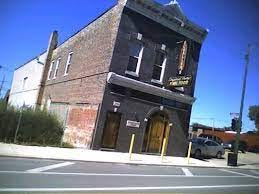

Schaller’s was particularly storied because it was across the street from the 11th Ward Democratic Headquarters, which made it the obvious place to gather for decades of powerful politicians. Remember, the 11th ward produced most of the mayors of the 20th century--Mayor Ed Kelly, successor Martin Kennelly, the real Mayor Daley, Michael Bilandic, and Richard M. Daley.
In lieu of a deep dive, let’s look at the first time Rick Kogan wrote about Schaller’s Pump in the Tribune, and the last time he wrote about it, as of today. As I’ve mentioned before, you can hardly write about anything in this town that Rick Kogan hasn’t covered already.
First time: 1987, when Kogan was still new to the Tribune and writing his “After Hours” column. He included Schaller’s in a round up of political bars.
“The bond between Chicago’s saloons and its politics is a strong one, nearly as old as the city itself and certainly as legendary,” he noted. Kogan’s description of Schaller’s then is timeless: “It’s not fancy and wears its age, roughly 105 years, for all to see. Inside is the lingering memory of deals hatched, promises made and careers broken. Tourists drop in now and then, as if visiting a shrine. But there is no aren’t-we-so-famous-so-how-about-buying-a-picture-of-the-Mayor-for-$5? pretentions here. This is a neighborhood tavern that had the benefit of a clientele that, for better or worse, had the power to make a city.”
Last time: 2021, when Kogan visited Bridgeport to check out the Ramova Theater as its rehab began.
“So, after a hard-hatted tour of the facility, I was back on the sidewalk and would have walked a couple of blocks south and stopped for a drink at Schaller’s Pump, once a neighborhood landmark and oasis, a place where politics and Ireland hung heavy in the air.
But Schaller’s closed in 2017 after 136 years. It was a great place but, oh well, life goes on.”
March 4, 1972
Chicago Daily Defender: Charlie Cherokee Says
…We want to wipe out cancer in your lifetime, was the slogan of the 72 Cancer Crusade luncheon this week. It featured the Nat King Cole story…
…Syndicated columnist Carl T. Rowan is the scheduled speaker for the Welfare Council of Metropolitan’s luncheon session, March 22…It’s the council’s 57th annual session and will feature seminars on new resources, new techniques, new programs and new concepts….It’s a new age….
….Stealing the ‘show’ during intermission at the Leontyne Price concert Sunday was Hayes Mayes, designer and boutique operator….His silver-blue mink coat matched his silver hairdo…One gazer called him a ‘frosted Robin Hood,’ while others inquired as to whether or not he was an actor…It was an exciting interlude…
….But no one stole the show from the regal Miss Price whose performance was rated as tops. She has no peer, one patron stated, and others describing her singing said: ‘Her voice is like soft water flowing from a vessel.’ …. Among the other star performers listening were Singers Della Reese and Carmen McRae…
And yes Younger Readers, the Defender ran a column called “Charlie Cherokee Says,” starting in the ‘40s. See the January 4 item here for more background.
March 4, 1972
Chicago Daily Defender editorial: Second ward vacancy
First, let’s get up to speed on Ald. Fred Hubbard, though no one has caught up to him yet in 1972:
Hubbard disappeared on May 20, 1971 when about $100,000 went missing from the federally-funded Chicago Plan, where Hubbard was the $25,000/year executive director. Remember that’s in addition to his salary as alderman. Chicago Plan was supposed to get Black Chicagoans into construction trade jobs.
Hubbard was driving a rental car that turned up abandoned in the Vegas Flamingo Hotel parking lot, and that’s the last anybody knows about him--except he’s been indicted by both a Cook County and a federal grand jury for embezzlement, fraud and forgery.
Moves began last July to have Hubbard formerly removed as alderman and replaced with a special election, but haven’t gone anywhere yet. How come? The Tribune wrote in a July 22, 1971 editorial that Mayor Daley’s floor leader, Tom Keane (widely considered the second most powerful guy in Chicago) “contends that any clarification of Hubbard’s status or lack of it might work injustices later to aldermen temporarily incapacitated by illness.” So Keane is stalling. Which means Mayor Daley is stalling. Of course, Mayor Daley would rather appoint somebody of his own to finish Hubbard’s term.
Another Trib editorial on August 13 declared, “The Democratic majority which controls the council could arrange for an election almost overnight, but its response to the 2d Ward plea amounts to a yawn.…The council has a legal right to declare his seat abandoned and to set a special election. By failing to do so, his colleagues are denying the voters of the 2d Ward their constitutional rights to representation and forcing the city’s taxpayer to pay a fugitive alderman….with a term just begun and no other vacancies in sight, the expenditure [for a special election] would seem worthwhile.”
The Tribune wrote a third editorial calling for holding a special election for Hubbard’s seat on January 6, after the 7th ward seat became vacant when Ald. Nicholas Bohling became a Circuit Court judge--and the City Council voted 26-6 against it. The special election could be held at the same time as the upcoming primary election, the Trib pointed out.
The ACLU filed a lawsuit on Feb. 3 on behalf of four 2nd ward voters to force the City Council to declare a special election, claiming the voters’ 14th Amendment rights to equal protection and due process were being violated.
Ald. Len Despres (5th) tried getting the council to approve a special election at the Council’s February meeting. He just got yelled at by Ald. Keane.
That gets us to March 4, 1972, and today’s Defender’s editorial. The Defender, of course, has been covering Hubbard, but this is their first editorial about his vacant Council seat according to the paper’s archives.
The Defender: “The repeated refusal of the City Council to fill the Second Ward Aldermanic vacancy, in particular, leaves no doubt in the public mind that the politicians are putting the Democratic Party’s interest above the need and well being of the black people in the ward.
“Ald. Fred Hubbard has been absent from the Second Ward for nearly a year. His absence has been associated with embezzlement of anti-poverty funds about which federal and state indictments have been issued.
“Some aldermen who have community pride and a social conscience have insisted that a special election be held so that the people of the Second Ward will have the representation to which they are entitled.
“Hubbard originally won his seat as an independent. The very obvious resolve of the City Council not to replace him through a special election is causing the tide of independence to rise again in the Second Ward.
“Political maneuvering as an exercise in the defense of a machine, though frowned upon by society, is nevertheless accepted and understood. It is only when such maneuvering boldly disregards the interest and rights of the citizens that it becomes odious and reprehensible.”
March 4-5, 1972
Chicago Daily News: Lu Palmer, “The vanishing black principal”
School busing is the hottest education issue right now, roiling local communities across the country, but Lu Palmer again calls it a “phony” issue.
“The real issue, I wrote recently, is whether or not black and poor children will be given an education to their needs and designed to bring them out of servitude.”
Today Palmer writes about another educational facet he says is a real problem: The fast dwindling number of Black school principals, which he calls another “spinoff from the push for so-called ‘integration’ of schools’.”
Palmer reports that “controversial former superintendent of schools at Evanston” Gregory Coffin, now chairman of the instruction department at Northeastern University, says the number of Black principals in Southern and border states “dropped a fantastic 90 per cent between 1960 and 1970.”
“What happened to the principals? Some are assigned to subordinate administrative jobs and are called ‘co-principals’ or ‘associate or assistant principal.’ The point is they lose what authority they had….The decision makers are supported by a voting populace which still will not accept the idea of a black principal supervising white teachers and white children, Coffin said.”
“Despite the dreary picture in the South, Coffin said, there are fewer black principals in the North than there are in the South. But what Coffin did not say is that in the North, where there is considerable agitation for black control of black schools, decision makers even balk at assigning black principals to black schools in large numbers.”
“Just as black educators warned, so-called integrated public school education will not only build white middle-class values into black children, it will displace countless numbers of black teachers as well as principals.”
…. “Black educators who are seriously concerned about all of the implications of ‘integrated’ education are beginning to put together models of what they call ‘alternative schools.’ These are schools over which no whites have any control. I will have a report on this new movement in a later column.”
Friends don’t let friends read the 1972 newspapers without reading Mike Royko too. Check out MIKE ROYKO 50 YEARS AGO TODAY here.
Do you dig spending time in 1972? If you came to THIS CRAZY DAY IN 1972 from social media, you may not know it’s part of the novel being serialized here, one chapter per month: “Roseland, Chicago: 1972” —FREE. It’s the story of Steve Bertolucci, 10-year-old Roselander in 1972, and what becomes of him. Check it out here.





